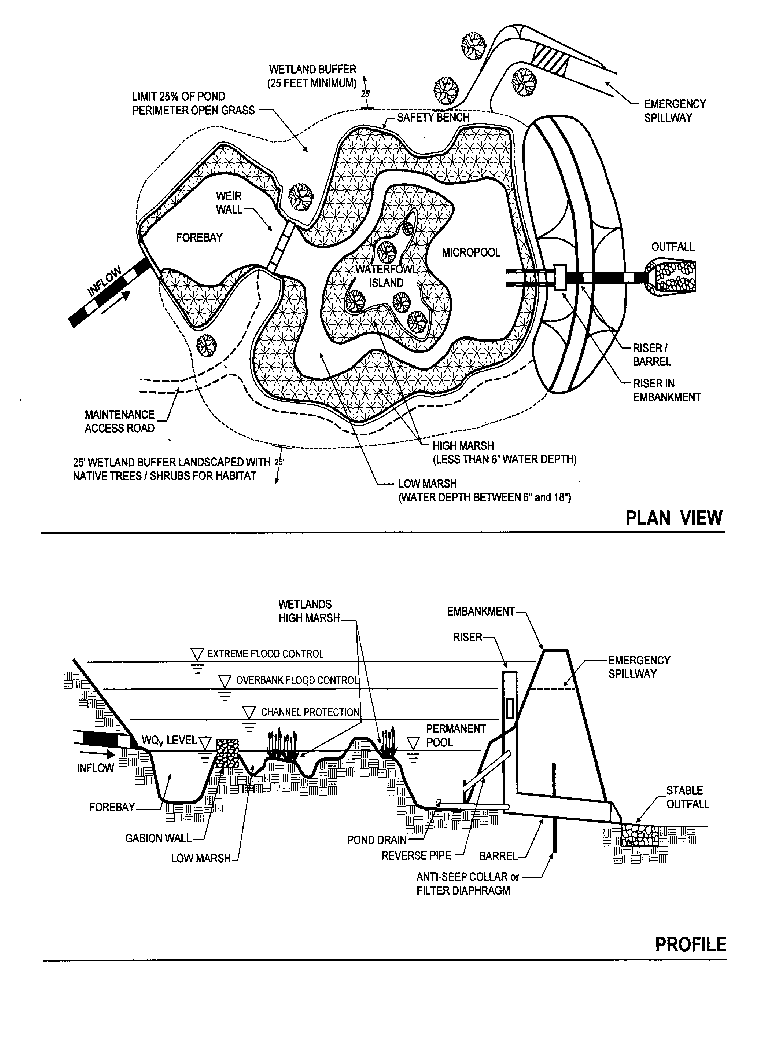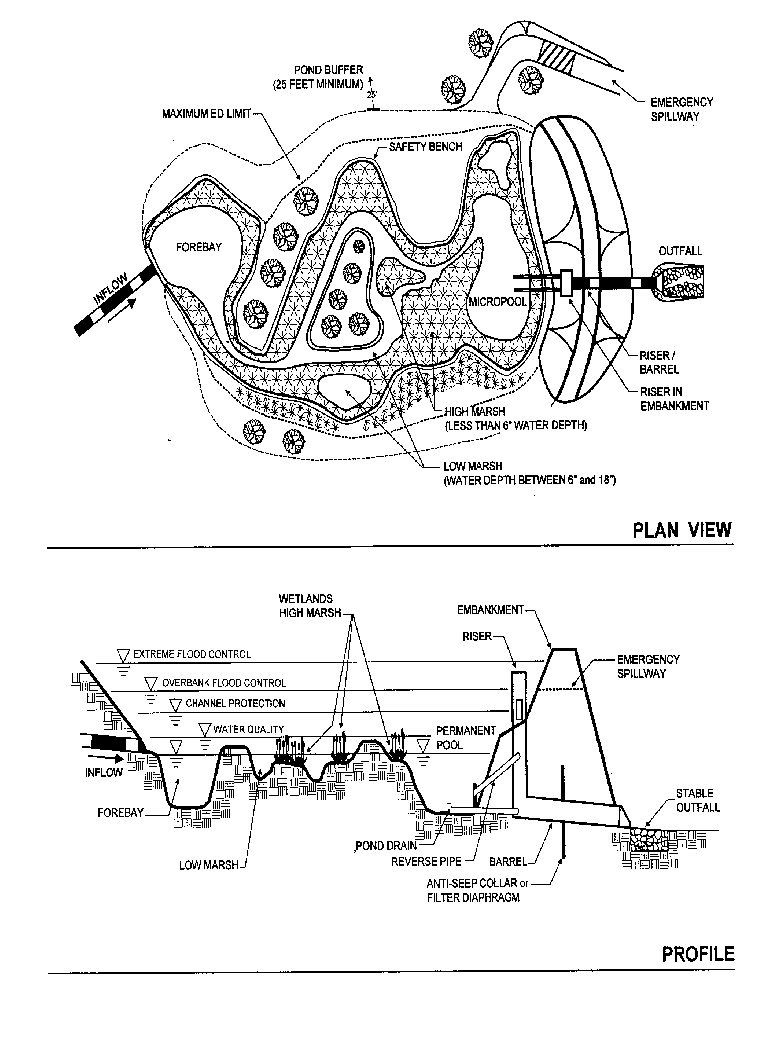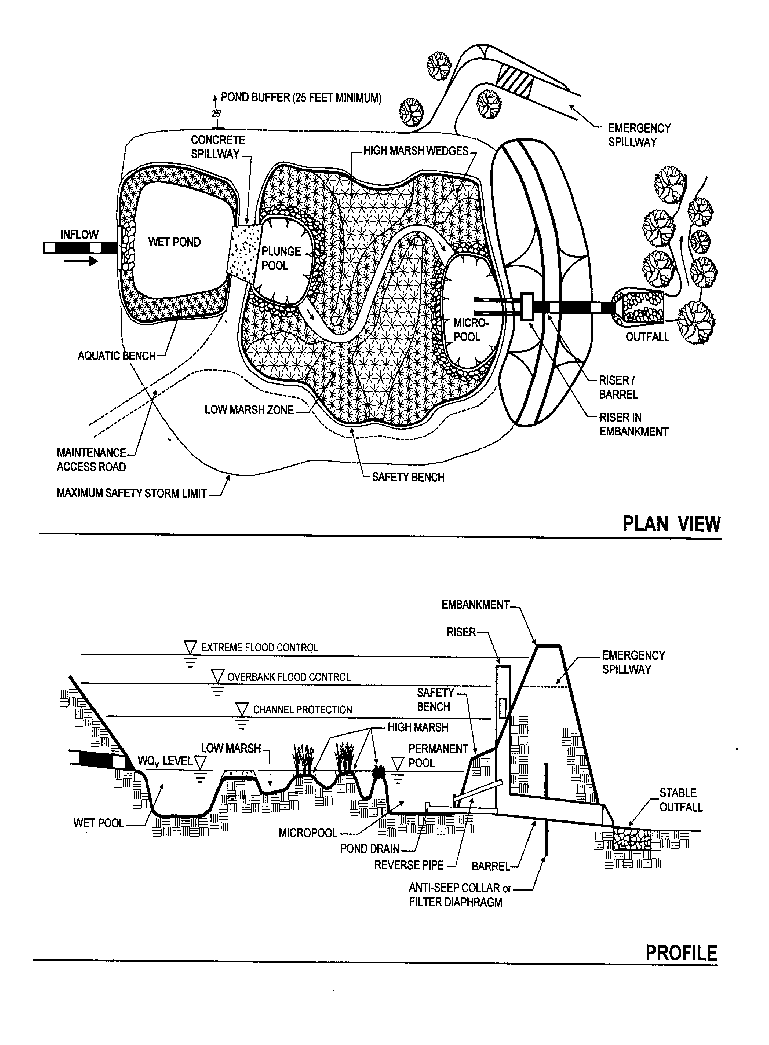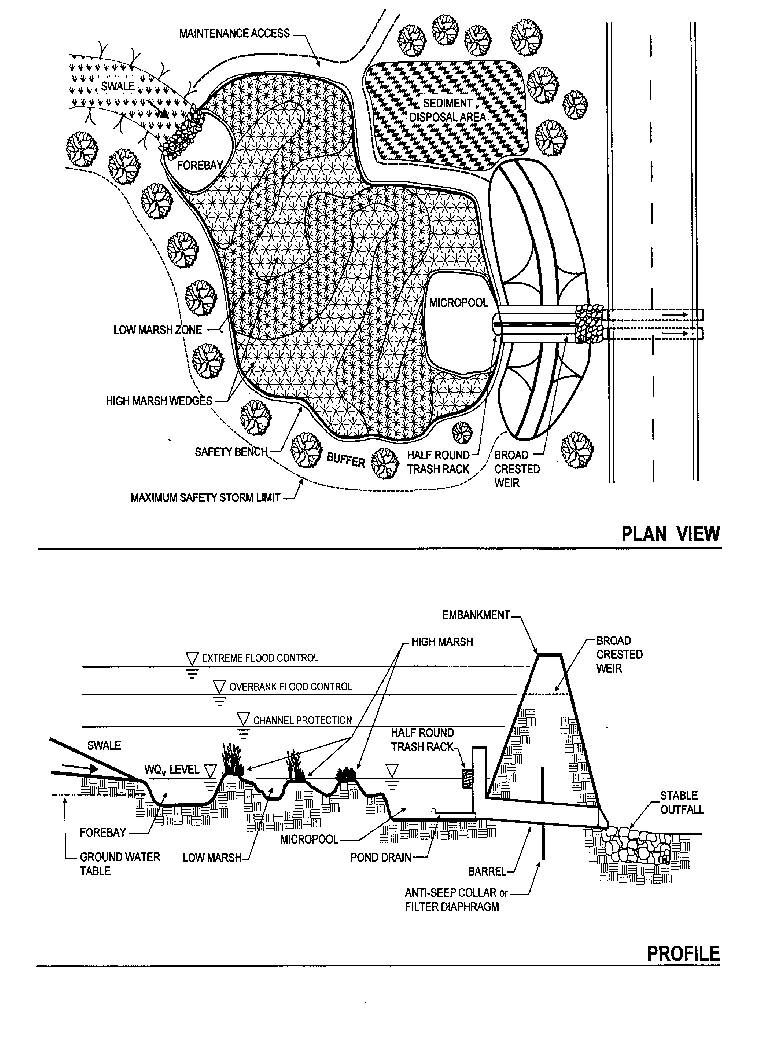
Stormwater Management Fact Sheet: Stormwater Wetland
Description
Stormwater wetlands (a.k.a. constructed wetlands) are structural practices similar to wet ponds (see Wet Ponds Fact Sheet) that incorporate wetland plants in a shallow pool. As stormwater runoff flows through the wetland, pollutant removal is achieved by settling and biological uptake within the practice. Wetlands are among the most effective stormwater practices in terms of pollutant removal, and also offer aesthetic value. While natural wetlands can sometimes be used to treat stormwater runoff that has been properly pretreated, stormwater wetlands are fundamentally different from natural wetland systems. Stormwater wetlands are designed specifically for the purpose of treating stormwater runoff, and typically have less biodiversity than natural wetlands both in terms of plant and animal life. There are several design variations of the stormwater wetland, each design differing in the relative amounts of shallow and deep water, and dry storage above the wetland.
Applicability
Wetlands are widely applicable stormwater treatment practices. While they have limited applicability in highly urbanized settings, and in arid climates, they have few other restrictions.
Regional Applicability
Stormwater wetlands can be applied in most regions of the United States,
with the exception of arid climates. In arid, and even in semi-arid climates,
it is difficult to design any stormwater practice that has a permanent pool.
Because wetlands are relatively shallow, water losses due to evaporation can
be high which can be critical for the wetland plants. This makes maintaining
the permanent pool in wetlands both more challenging and more important than
maintaining the pool of a wet pond (see Wet
Pond Fact Sheet).
Ultra Urban Areas
Ultra urban areas
are densely developed urban areas in which little pervious surface exists. It
is difficult to use wet ponds in the ultra urban watershed because of the land
area each wetland consumes. They can, however, be used in these environments
if a relatively large area is available downstream of the site.
Stormwater Hotspots
Stormwater hotspots
are areas where land use or activities generate highly contaminated runoff,
with concentrations of pollutants in excess of those typically found in stormwater.
A typical example is a gas station. Wetlands can accept runoff from stormwater
hotspots, but need significant separation from groundwater if they will be used
for this purpose. Caution also needs to be exercised for stormwater wetlands
to ensure that pollutants in stormwater runoff do not work their way up the
food chain of aquatic organisms living in or near the wetland.
Stormwater Retrofit
A stormwater retrofit is a stormwater management practice (usually structural)
put into place after development has occurred, to improve water quality, protect
downstream channels, reduce flooding, or meet other watershed restoration objectives.
When retrofitting an entire watershed, stormwater wetlands have the advantage
of providing both educational and habitat value. One disadvantage to wetlands,
however, is the difficulty storing large amounts of runoff without consuming
a large amount of land. It is also possible to incorporate wetland elements
into existing practices, such as wetland plantings (see Wet
Pond and Dry Extended Detention Pond
Fact Sheets).
Cold Water (Trout) Streams
Wetlands pose
a moderate risk to cold water systems because of their potential for stream
warming. When water remains in the permanent pool, it is heated by the sun.
A study in Prince Georges County, MD investigated the thermal impacts of a wide
range of stormwater management practices. (Galli, 1990). In this study, only
one wetland was investigated, which was an extended detention wetland (see
Design Variations). The practice increased the average temperature of stormwater
runoff that flowed through the practice by about 3 F. While this is less than
the temperature increase associated with wet ponds (see Wet
Ponds Fact Sheet), it cannot be concluded from one study that wetlands necessarily
increase temperatures less than wet ponds. In fact, wetlands may have a greater
potential to increase temperature because the shallow portions of wetlands can
easily be warmed by the sun.
Locational and Design Considerations
In addition to the broad concerns described above, designers need to consider conditions at the site level. In addition, they need to incorporate design features to improve the longevity and performance of the practice, while minimizing the maintenance burden.
Locational Considerations
Designers need
to ensure that stormwater wetlands are feasible for a site. The following section
provides basic guidelines for locating wetlands.
Wetlands need sufficient drainage area to maintain a shallow permanent pool. In humid regions, about twenty-five acres of drainage area are needed, but a larger areas may be needed in regions with less rainfall.
Slope
Wetlands can be used on sites with an upstream slope up to about 15%. The local slope should be relatively shallow, however. While there is no minimum slope requirement, there does need to be enough elevation drop from the inlet to the outlet to ensure that hydraulic conveyance by gravity is feasible (generally about three to five feet).
Soils /Topography
Wetlands can be used in almost all soils and geology, with minor design adjustments for regions of karst topography. (See Design Considerations).
Groundwater
Unless they receive hotspot runoff, wetlands can often intersect the groundwater table. Some research suggests that pollutant removal is moderately reduced when groundwater contributes substantially to the pool volume (Schueler, 2000) (for more information see Influence of Groundwater on Performance of Stormwater Ponds in Florida, Article 78 in The Practice of Watershed Protection). It is assumed that wetlands would have a similar response.
Design Considerations
Specific designs
may vary considerably, depending on site constraints or preferences of the designer
or community. There are some features, however, that should be incorporated
into most wetland designs. These design features can be divided into five basic
categories: pretreatment, treatment, conveyance, maintenance
reduction, and landscaping (for more information see the Manual
Builder Category).
Pretreatment
Pretreatment is used to settle out coarse sediment particles prior to entry in the main wetland cell. By removing sediments before they reach the wetland, the maintenance burden of the wetland is reduced. In wetlands, pretreatment is achieved with a sediment forebay. A sediment forebay is a small pool (typically about 10% of the volume of the permanent pool). Coarse particles remain trapped in the forebay, and maintenance is performed on this smaller pool, eliminating the need to dredge or clean out sediments from the entire wetland.
Treatment
Treatment design features help enhance the ability of a stormwater treatment practice to remove pollutants. Several features can enhance the ability of wetlands to remove pollutants from stormwater runoff. The purpose of most of these features is to increase the amount of time and flowpath that stormwater remains in the wetland. Some typical design features include:
Conveyance
Conveyance of runoff into and through a stormwater practice is a critical component of any stormwater design. Stormwater should be conveyed to and from practices safely and to minimize erosion potential. The outfall of pond systems should always be stabilized to prevent scour. In addition, an emergency spillway should be provided to safely convey large flood events. In order to prevent warming at the outlet channel, designers should provide shade around the channel at the wetlands outlet.
Maintenance Reduction
In addition to regular maintenance activities, several design features can be incorporated to ease the maintenance burden of stormwater wetlands.
One potential maintenance concern in stormwater wetlands is clogging of the outlet. Wetlands should be designed with a non-clogging outlet such as a reverse-slope pipe, or a weir outlet with a trash rack. A reverse slope pipe draws from below the micropool extending in a reverse angle up to the riser and establishes the water elevation of the micropool. Because these outlets draw water from below the level of the micropool, they are less likely to be clogged by floating debris. Another general rule is that no orifice should be less than 3" in diameter (smaller orifices are generally more susceptible to clogging, without specific design considerations to reduce this problem).
Wetlands should incorporate design features that make sediment cleanouts of both the forebay and the shallow pool easier. Wetlands should have direct maintenance access to the forebay, to allow this relatively routine (five to seven year) sediment cleanouts. In addition, the shallow pool should generally have a drain to draw down the wetland for the more infrequent dredging of the main cell of the wetland.
Landscaping
Landscaping of wetlands can make them an asset to a community, and can also enhance their pollutant removal. To ensure the establishment and survival of wetland plants, a landscaping plan should provide detailed information about the plants selected, when they will be planted, and a strategy for maintaining them. The plan should detail wetland plant species, as well as vegetation to be established adjacent to the wetland.
A variety of techniques can be used to establish wetland plants. The most effective technique is the use of nursery stock as dormant rhizomes, live potted plants, or bare root stock. A "wetland mulch," soil from a natural wetland or a designed "wetland mix," can be used to supplement wetland plantings or alone to establish wetland vegetation. Wetland mulch carries with it the seed bank from the original wetland, and can help to enhance diversity in the wetland. The least expensive option to establish wetlands is to allow the wetland to colonize itself. One disadvantage to this last technique is that invasive species such as cattails or Phragmites may dominate the wetland (for more information see Nutrient Dynamics and Plant Diversity in Volunteer and Planted Stormwater Wetlands, Article 89 in The Practice of Watershed Protection).
When developing a plan for wetland planting, care needs to be taken to ensure that plants are established in the proper depth and within the planting season. This season varies regionally, and is generally between two and three months long in the spring to early summer. Plant lists are available for various regions of the United States through wetland nurseries, extension services, or conservation districts.
Design Variations
There are several variations of the wetland design. The designs differ in the proportion of the volume of the wetland in deep pool, high marsh, low marsh, and whether volume is provided for extended detention above the wetland surface. Other design variations help to make wetland designs practical in cold climates.
In the shallow marsh design, most of the wetland volume is in the relatively shallow high marsh or low marsh depths. The only deep areas of the shallow wetland design are the forebay at the inlet to the wetland, and the micropool at the outlet. One disadvantage of the shallow marsh design is that the pool is very shallow and a large amount of land is typically needed to store the water quality volume (i.e., the volume of runoff to be treated in the wetland) (see Figure 1).

Extended Detention Wetland
This design is similar to the shallow marsh, but with more storage above the surface of the marsh. Stormwater is temporarily ponded above the surface in the extended detention zone for between twelve and twenty-four hours. This extended detention wetland can treat a greater volume of stormwater in a smaller space than the shallow wetland design. In the extended detention wetland option, plants that can tolerate wet and dry periods should be planted along the shorelines of the wetlands. (See Figure 2).

Pond/Wetland System
The pond/wetland system combines a wet pond (see Wet Pond Fact Sheet) and a shallow marsh. Stormwater runoff flows through the wet pond and into the shallow marsh. Like the extended detention wetland, this design requires less surface area than the shallow marsh because much of the practice is relatively deep (i.e., six to eight feet) (see Figure 3).

Pocket Wetland
This design is very similar to the Pocket Pond (see Wet Pond Fact Sheet). In this design, the bottom of the wetland intersects the groundwater, which helps to maintain the permanent pool. Some evidence suggests that groundwater flows may reduce the overall effectiveness of stormwater management practices (Schueler, 2000). This option may be used when there is not significant drainage area to maintain a permanent pool for the stormwater wetland (see Figure 4).

Gravel-Based Wetlands
In this design, runoff flows through a rock filter with wetland plants at the surface. Pollutants are removed through biological activity on the surface of the rocks, as well as by pollutant uptake of the plants. This practice is fundamentally different from other wetland designs because, while most wetland designs behave like Wet Ponds with differences in grading and landscaping, gravel-based wetlands are more similar to a filtering system. A proprietary version of the gravel-based wetland, StormTreat�, operates on a similar principle (for more information see The StormTreat System: A New Technology for Treating Stormwater Runoff, Article 96 in The Practice of Watershed Protection).
Regional Variations
Cold Climates
Cold climates present many challenges to designers of wetlands. During the spring snowmelt, a large volume of runoff occurs in a short time, which carries a relatively high pollutant load. In addition, cold winter temperatures cause freezing of the shallow pool as well as freezing up inlet and outlet structures. Finally, high salt concentrations are spread by road salting which can impact wetland vegetation. Also sediment loads from road sanding can be high, and cause premature loss of treatment capacity.
A key problem with stormwater wetlands (particularly shallow marshes), is that the practice has very shallow water depths. Therefore, much of the volume in the wetland can be lost when the surface ices over. One study found that the performance of a wetland system was moderately diminished during the spring snowmelt because the outlet and surface of the wetland had frozen. Sediment and pollutants in snowmelt and rainfall events "skated" over the surface of the wetland, depositing at the outlet of the wetland. When the ice melted, this sediment was washed away by storm events (Oberts, 2000) (for more information see Performance of Stormwater Ponds and Wetlands in Winter, Article 71 and Pollutant Removal Dynamics of Three Canadian Wet Ponds, Article 75 in The Practice of Watershed Protection). Several design features can help minimize this problem, including:
The salt and sand used to remove ice from roads and parking lots may also create a problem for wetlands in cold climates. When wetlands receive highway runoff, or parking lots, salt tolerant wetland plant species, such as Pickerelweed or Cord Grass should be used. (Contact a local nursery or extension agency for more information in your region). In addition, designers should consider increasing the size of the sediment forebay to capture the increased sediment load from road sanding.
Karst Topography
In karst (i.e., limestone) topography, the bottom of wetlands should incorporate an impermeable liner to prevent groundwater contamination or sinkhole formation, and to help maintain the shallow pool.
Limitations
Some limitations of stormwater wetlands include:
Maintenance Considerations
Several regular maintenance and inspection practices are needed for stormwater wetlands as outlined below:
|
Table
1. Regular Maintenance Activities for Wetlands |
|
|
Activity |
Schedule |
|
Replace wetland vegetation to maintain at least 50% surface area coverage in wetland plants after the second growing season. |
One-Time |
|
Inspect for invasive vegetation and remove where possible. |
Semi-Annual Inspection |
|
Inspect for damage to the embankment and inlet/outlet structures. Repair as necessary. Note signs of hydrocarbon build-up, and deal with appropriately. Monitor for sediment accumulation in the facility and forebay. Examine to ensure that inlet and outlet devices are free of debris and operational. |
Annual |
|
Repair undercut or eroded areas. |
As Needed Maintenance |
|
Clean and remove debris form inlet and outlet structures Mow side slopes. |
Frequent (3-4 times/year) Maintenance |
|
Supplement wetland plants if a significant portion have not established (at least 50% of the surface area). Harvest wetland plants that have been "choked out" by sediment build-up. |
Annual Maintenance (if needed) |
|
Removal of sediment form the forebay. |
5 to 7 year Maintenance |
|
Monitor sediment accumulations, and remove sediment when the pool volume has become reduced significantly, plants are "choked" with sediment, or the wetland becomes eutrophic. |
20 to 50 year Maintenance |
Effectiveness
Stormwater treatment practices can be used to achieve four broad resource protection goals. These include: Flood Control, Channel Protection, Groundwater Recharge, and Pollutant Removal (see the Manual Builder Category for more information). Wetlands, however can only meet flood control and channel protection, and pollutant removal goals.
Flood Control
One objective of stormwater treatment practices can be to reduce the flood hazard associated with large storm events by reducing the peak flow associated with these storms. Wetlands can easily be designed for flood control, by providing flood storage above the level of the wetland surface.
Channel Protection
One result of urbanization is the channel erosion caused by increased stormwater runoff. When used for channel protection, wetlands have traditionally been designed to control the two-year storm. It appears that this design storm has not been effective in preventing channel erosion, and recent research suggests that control of a smaller storm may be more appropriate (MacRae, 1996). Choosing a smaller design storm (one-year) and providing longer detention time (12 to 24 hours) are thought to be the best methods to reduce channel erosion.
Groundwater Recharge
Wetlands usually cannot provide groundwater recharge. The build-up of sediment and organic matter debris at the bottom of the wetland prevents the downward movement of water into the subsoil.
Pollutant Removal
Wetlands are among the most effective practices for removing stormwater pollutants. Over thirty-five research studies have estimated the effectiveness of wetlands. Wetlands have high pollutant removal rates, and are more effective than any other practice at removing nitrate and bacteria. Table 2 provides pollutant removal data derived from the CWP's National Pollutant Removal Database for Stormwater Treatment Practices:
|
Table 2. Typical Pollutant Removal Rates of Wetlands (%) (Winer, 2000) |
||||
|
Pollutant |
Stormwater Treatment Practice Design Variation |
|||
|
Shallow Marsh |
ED Wetland1 |
Pond/Wetland System |
Submerged Gravel Wetland1 |
|
|
TSS |
83�51 |
69 |
71�35 |
83 |
|
TP |
43�40 |
39 |
56�35 |
64 |
|
TN |
26�49 |
56 |
19�29 |
19 |
|
NOx |
73�49 |
35 |
40�68 |
81 |
|
Metals |
36 - 85 |
(-80) - 63 |
0 - 57 |
21 - 83 |
|
Bacteria |
761 |
NA |
NA |
78 |
|
1:Data based on fewer than five data points |
||||
There is considerable variability in the effectiveness of wetlands, but it is believed that proper design and maintenance may help to improve their performance. The siting and design criteria presented in this sheet reflect the best current information and experience to improve the performance of wetlands.
Cost Considerations
Wetlands are a relatively inexpensive stormwater practice. Construction cost data for wetlands are rare, but one simplifying assumption is that they are typically about 25% more expensive than stormwater ponds of an equivalent volume. Using this assumption, an equation developed by Brown and Schueler (1997) to estimate the cost of Wet Ponds can be modified to estimate the cost of stormwater wetlands using the equation:
C = 30.6V0.705
Where:
C = Construction, Design
and Permitting Cost
V = Wetland Volume
needed to control the 10-year storm (cubic feet)
Using this equation,
typical construction costs are:
$ 57,100 for a 1 acre-foot
facility
$ 289,000 for a 10
acre-foot facility
$ 1,470,000 for a
100 acre-foot facility
Wetlands consume about 3% to 5% of the land that drains to them, which is relatively high compared with other stormwater management practices. In areas where land value is high, this may make wetlands an infeasible option.
For wetlands, the annual cost of routine maintenance is typically estimated at about 3% to 5% of the construction cost. Alternatively, a community can estimate the cost of the maintenance activities outlined in the maintenance section. Wetlands are long-lived facilities (typically longer than 20 years). Thus, the initial investment into these systems may be spread over a relatively long time period.
While no studies are available on wetlands in particular, there is some evidence to suggest that wet ponds may provide an economic benefit by increasing property values. The results of one study suggests that "pond frontage" property can increase the selling price of new properties by about 10% (US EPA, 1995). Another study reported that the perceived value (i.e., the value estimated by residents of a community) of homes was increased by about 15 to 25% when located near a wet pond (Emmerling-Dinovo, 1995). It is anticipated that well-designed wetlands, which incorporate additional aesthetic features, would have the same benefit.
References
Brown, W. and T. Schueler. 1997. The Economics of Stormwater BMPs in the Mid-Atlantic Region. Prepared for: Chesapeake Research Consortium. Edgewater, MD. Center for Watershed Protection. Ellicott City, MD.
Center for Watershed Protection (CWP), Environmental Quality Resources and Loiederman Associates. 1998. Maryland Stormwater Design Manual. Prepared for: Maryland Department of the Environment. Baltimore, MD. http://www.mde.state.md.us/environment/wma/stormwatermanual/mdswmanual.html
Center for Watershed Protection (CWP). 1997. Stormwater BMP Design Supplement for Cold Climates. Prepared for: US EPA Office of Wetlands, Oceans and Watersheds. Washington, DC.
Denver Urban Drainage and Flood Control District. 1992. Urban Storm Drainage Criteria Manual; Volume 3 - Best Management Practices. Denver, CO.
Egan, T., S. Burroughs and T. Attaway. 1995. Packed Bed Filter. In: Proceedings Fourth Biennial Stormwaer Research Conference. Clearwater, FL. 320 pp.
Emmerling-Dinovo, C. 1995. Stormwater Detention Basins and Residential Locational Decisions. Water Resources Bulletin, 31(3): 515-521
Galli, F. 1990. Thermal Impacts Associated with Urbanization and Stormwater Best Management Practices. Metropolitan Council of Governments. Prepared for: Maryland Department of the Environment. Baltimore, MD.
Horsley, S. 2000. The Storm Treat System - A New Technology for Treating Stormwater Runoff, Article 96 in The Practice of Watershed Protection. Center for Watershed Protection. Ellicott City, MD.
MacRae, C. 1996. Experience from Morphological Research on Canadian Streams: Is Control of the Two-Year Frequency Runoff Event the Best Basis for Stream Channel Protection? IN: Effects of Watershed Development and Management on Aquatic Ecosystems. American Society of Civil Engineers. Edited by L. Roesner. Snowbird, UT. pp. 144-162.
McLean, J. 2000. Mosquitos in Constructed Wetlands - A Management Bugaboo?, Article 100 in The Practice of Watershed Protection. Center for Watershed Protection. Ellicott City, MD.
Mellichamp, T., J. Matthews, and M. Murray. 1996. Selection and Planting Guide for Aquatic and Wetland Plants in the Piedmont Region of North Carolina. University of North Carolina. Charlotte, NC.
Minnesota Pollution Control Agency. 1989. Protecting Water Quality in Urban Areas: Best Management Practices. Minneapolis, MN.
Oberts, G. 2000. Performance of Stormwater Ponds and Wetlands in Winter, Article 71 in The Practice of Watershed Protection. Center for Watershed Protection. Ellicott City, MD.
Reuter, J., T. Djohan and C. Goldman. 1992. The Use of Wetlands for Nutrient removal from Surface Runoff in a Cold-Climate Region of California-Results from a Newly Constructed Wetland at Lake Tahoe. Journal of Environmental Management, 36:35-53.
Schueler, 1992. Design of Stormwater Wetland Systems: Guidelines for Creating Diverse and Effective Stormwater Wetlands in the Mid-Atlantic Region. Metropolitan Washington Council of Governments. Washington, DC.
Schueler, T. 2000. Comparative Pollutant Removal Capability of Urban Stormwater Treatment Practices: A Reanalysis, Article 64 in The Practice of Watershed Protection. Center for Watershed Protection. Ellicott City, MD.
Schueler, T. 2000. Influence of Groundwater on Performance of Stormwater Ponds in Florida, Article 78 in The Practice of Watershed Protection. Center for Watershed Protection. Ellicott City, MD.
Thunhorst, G.A. 1993. Wetland Planning Guide for the Northeastern United States Plants for Wetland Creation, Restoration, and Enhancement. Environmental Concern, Inc. St. Michaels, MD.
US EPA. 1995. Economic Benefits of Runoff Controls. Office of Wetlands, Oceans, and Watersheds. Washington, DC Publ. 8410S-95-0022.
US EPA. 1993. Office of Water. Guidance to Specify Management Measures for Sources of Nonpoint Pollution in Coastal Waters. EPA-840-B-92-002. Washington, DC.
Watershed Management Institute (WMI). 1997. Operation, Maintenance, and Management of Stormwater Management Systems. Prepared for: US EPA Office of Water. Washington, DC
Winer, R. 2000. National Pollutant Removal Database for Stormwater Treatment Practices: 2nd Edition. Center for Watershed Protection. Ellicott City, MD.